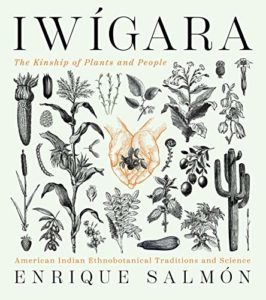 The Kinship of Plants and People. American Indian Ethnobotanical Traditions and Science
The Kinship of Plants and People. American Indian Ethnobotanical Traditions and Science
Written by Dr. Enrique Salmón
Published By Timber Press
Reviewed By Amanda Sloan
Lifting this book from its mailing box, I pondered its title first: Iwígara: the Kinship of Plants and People. American Indian Ethnobotanical Traditions and Science. I read that the author, Dr. Enrique Salmón, is an ethnobotanist and expert on indigenous cultural concepts of the natural world. He is head of California State University East Bay’s American Indian Studies program and a member of the Raramuri tribe, an indigenous people of northern Mexico.
What would I be treated to in this book’s pages? Mythic stories of important plants from cultural tradition? Scientific descriptions of plants’ characteristics, biology, and habitat? Medicinal and culinary uses of plants and traditional ways of preparing them? Beautiful photos and historical images? Just a few of these would make this compendium unique.
As I dove in eagerly, however, I realized that this book is rich in all these elements. It is organized as a traditional botany, with sections on each of 80 native plants presented in alphabetical order. But the sections are written as relatable narratives, mixing scientific and horticultural information, cultural uses, stories handed down, and Dr. Salmón’s personal memories of the plants. It is part of a long tradition of plant people writing about plants, with an angle that is new—and increasingly essential–to those of us ‘plant people’ not familiar with American native ethnobotany.
Dr. Salmón’s introduction to the book explains the Raramuri concept of Iwígara: “that all life, spiritual and physical, is interconnected in a continual cycle.” He explains that this concept is embraced by American native cultures across the continent, from the western Pueblo to the eastern Cherokee. His current research explores how this concept, combined with traditional plant understandings and foodways, may contribute to feeding our planet during this time of abrupt climate change.
As an ecologically oriented landscape professional, I have kept this book by my side as I create plant palettes for my landscape designs this past season. I have already converted all my plant lists to native plants—-but this wonderful resource provides so much more depth to my knowledge of why using natives is now more important than ever. It’s not just that, for instance, substituting highbush blueberry for winged euonymus provides berries for birds—although that is certainly key. It’s that the blueberry belongs in our landscapes as an integral part of human cultural history. Plants weave our human lives as closely with the natural world as they do the lives of other creatures, and they always have. It’s a crucial lesson for our lives today.
About the Reviewer
Amanda Sloan has almost 30 years of experience on a wide variety of projects in landscape design including native plant gardens, dog parks, accessible trails, school and playground gardens, rain gardens, and environmental design throughout New England. Her experience includes project design and management from conceptual design through bid documents; peer review; presentation illustrations; and writing. She is certified by Rhode Island CRMC in Invasive Plant Management. She has lectured throughout New England on ecological landscape design topics.

 The Kinship of Plants and People. American Indian Ethnobotanical Traditions and Science
The Kinship of Plants and People. American Indian Ethnobotanical Traditions and Science